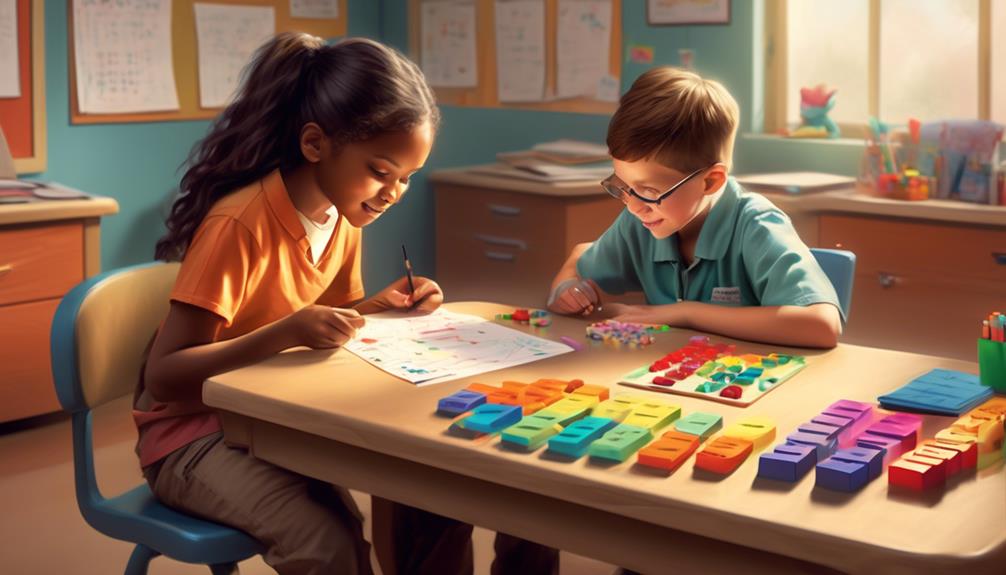Strategies for Dealing With Dyscalculia in Elementary Students

Strategies for Dealing With Dyscalculia in Elementary Students:
- Identifying signs
- Creating a supportive learning environment
- Using multisensory teaching methods
- Breaking down math concepts into smaller steps
- Providing extra practice
- Incorporating technology
- Collaborating with parents
- Implementing individualized learning plans
These strategies can make a significant difference in helping students with dyscalculia thrive in math.
Identifying the Signs of Dyscalculia
To help you better understand if a student may be struggling with dyscalculia, it's important to be able to identify the signs early on. Recognizing these signs can lead to early intervention, which is crucial for the student's academic success. So, what're some signs to look out for?
One of the most common signs of dyscalculia is difficulty with basic number recognition. The student may have a hard time identifying and understanding numbers, both in written and spoken forms. They might struggle to count, mix up the order of numbers, or have trouble understanding number patterns.
Another sign to watch for is difficulty with basic math operations. The student may struggle with addition, subtraction, multiplication, and division. They might've a hard time understanding the concepts and applying them to solve problems. This can lead to frustration and a lack of confidence in their mathematical abilities.
Additionally, poor spatial awareness and difficulty with measurements can also indicate dyscalculia. The student might struggle with understanding the relationship between objects and their sizes, have trouble with estimating distances, or find it challenging to read and interpret graphs or charts.
Creating a Supportive Learning Environment
When it comes to helping students with dyscalculia succeed, creating a supportive learning environment is key.
This means making classroom accommodations to meet their specific needs, such as providing extra time on tests or using visual aids to reinforce concepts.
Additionally, individualized instruction can greatly benefit these students, allowing them to learn at their own pace and receive targeted support.
Classroom Accommodations
Creating a supportive learning environment for elementary students with dyscalculia can greatly enhance their academic success. Inclusive teaching and differentiated instruction are essential strategies to ensure that these students receive the support they need to thrive in the classroom.
Here are four classroom accommodations that can make a significant difference:
- Provide visual aids: Use charts, diagrams, and manipulatives to help students visualize mathematical concepts and make connections.
- Break down tasks: Divide complex problems or assignments into smaller, more manageable steps to prevent overwhelming students with dyscalculia.
- Allow extra time: Give students with dyscalculia additional time to complete assignments and tests, recognizing that they may need more time to process information and solve problems.
- Offer alternative assessments: Provide alternative ways for students to demonstrate their understanding of mathematical concepts, such as oral presentations or hands-on projects.
Individualized Instruction
Now let's explore how individualized instruction can further create a supportive learning environment for elementary students with dyscalculia.
When it comes to helping students with dyscalculia, a personalized approach is key. By using differentiated instruction, teachers can tailor their lessons to meet the specific needs of each student. This means providing different strategies and resources to help them understand and grasp mathematical concepts.
For example, some students may benefit from using manipulatives or visual aids, while others may require additional practice or repetition. By taking the time to understand each student's strengths and weaknesses, teachers can effectively cater to their individual learning needs.
This not only helps students with dyscalculia feel supported and understood, but it also empowers them to succeed in their mathematical journey.
Utilizing Multisensory Teaching Methods
When it comes to helping elementary students with dyscalculia, utilizing multisensory teaching methods can make a big difference.
Hands-on activities allow students to engage their sense of touch and actively participate in the learning process.
Visual aids such as charts, diagrams, and manipulatives can help them visualize abstract mathematical concepts.
Incorporating movement-based learning activities like games and physical exercises can also enhance their comprehension and retention of math skills.
Hands-On Activities
To engage elementary students with dyscalculia, incorporate hands-on activities that utilize multisensory teaching methods. These activities not only make learning fun, but also help students with dyscalculia better understand mathematical concepts.
Here are four hands-on activities that can be effective in supporting their learning:
- Sensory integration: Use materials that engage multiple senses, such as tactile objects or textured surfaces. For example, have students trace numbers or shapes on sandpaper or use manipulative materials like counting blocks.
- Manipulative materials: Provide students with physical objects they can manipulate to represent numbers and quantities. This can include items like counting cubes, base-ten blocks, or fraction tiles.
- Interactive games: Incorporate interactive games that require students to physically move or interact with objects while solving mathematical problems. This can help make abstract concepts more concrete and engaging.
- Real-world applications: Connect mathematical concepts to real-world scenarios. For instance, have students measure ingredients while baking or use a clock to practice telling time.
Visual Aids
Incorporating visual aids into lessons can greatly enhance the learning experience for elementary students with dyscalculia, allowing them to better grasp mathematical concepts through multisensory teaching methods.
Visual aids such as interactive games and manipulatives provide a tangible and engaging way for students to interact with numbers and mathematical operations.
Interactive games can be a fun and effective way to reinforce mathematical concepts. They allow students to actively participate in the learning process, making it more enjoyable and memorable. For example, a game where students have to solve equations or count objects can help them practice their math skills in a playful manner.
Manipulatives, on the other hand, are physical objects that students can manipulate to understand mathematical concepts. They provide a hands-on experience and help students visualize abstract ideas. For instance, using blocks or cubes to represent numbers can help students understand place value or addition and subtraction.
Movement-Based Learning
As you continue to explore strategies for supporting elementary students with dyscalculia, let's now turn our attention to the effectiveness of movement-based learning and how it can further enhance their mathematical understanding.
Incorporating sensory integration and kinesthetic learning into their lessons can make a world of difference for these students. Here's why:
- Engages multiple senses: Movement-based learning encourages students to use their senses of touch, sight, and proprioception, promoting a deeper understanding of mathematical concepts.
- Enhances memory retention: By actively engaging in physical activities related to math, such as using manipulatives or participating in math games, students are more likely to remember what they've learned.
- Fosters positive associations: Movement-based learning makes math fun and enjoyable, helping students develop a positive attitude towards the subject.
- Supports cognitive development: Physical movement stimulates brain activity, improving cognitive functions such as problem-solving and critical thinking.
Incorporating movement-based learning strategies into your teaching can create a dynamic and inclusive learning environment, enabling students with dyscalculia to thrive in their mathematical journey.
Breaking Down Math Concepts Into Smaller Steps
Breaking down math concepts into smaller steps can greatly assist elementary students with dyscalculia in understanding and mastering mathematical concepts. For students with dyscalculia, complex math concepts may seem overwhelming and difficult to grasp. By breaking down these concepts into smaller, more manageable steps, you can provide the necessary scaffolding for their learning.
When teaching math to students with dyscalculia, it's important to start with the basics and build upon their existing knowledge. Break down complex math concepts into smaller, more digestible pieces. For example, if you're teaching multiplication, begin by introducing the concept of repeated addition. Once they understand this concept, gradually introduce them to the multiplication table and the different strategies for multiplication.
Additionally, provide visual aids and manipulatives to help students with dyscalculia visualize and understand math concepts. Use counters, number lines, and diagrams to represent numbers and operations. These visual representations can make abstract concepts more concrete and easier to comprehend.
Remember to go at the student's pace and provide ample practice opportunities. Allow them to master each step before moving on to the next one. Breaking down math concepts into smaller steps not only helps students with dyscalculia build their understanding but it also boosts their confidence and motivation in learning math.
Providing Extra Practice and Repetition
To help elementary students with dyscalculia improve their math skills, it's important to provide them with extra practice and repetition. This targeted approach can help reinforce concepts and build confidence in their abilities.
Here are four strategies you can implement to ensure your students get the extra practice and repetition they need:
- Math Games: Incorporating fun and interactive games into your lessons can make practicing math skills enjoyable for students. Whether it's a board game or an online activity, these games provide an opportunity for students to practice their math skills in a relaxed and engaging way.
- Daily Review: Devote a portion of each math lesson to reviewing previously learned concepts. This daily review helps reinforce important skills and ensures that students don't forget what they've learned.
- Homework Assignments: Assigning regular math homework gives students the chance to practice independently at home. Make sure to provide clear instructions and examples, and offer support if needed.
- Small Group or One-on-One Instruction: Offering additional support through small group or one-on-one instruction allows you to tailor your teaching to meet the individual needs of students with dyscalculia. This personalized attention can help reinforce concepts and provide extra practice opportunities.
Incorporating Technology and Educational Apps
Incorporating technology and educational apps can significantly enhance math learning for elementary students with dyscalculia. By using interactive tools, such as virtual manipulatives and gamified learning, students can engage with math concepts in a fun and interactive way. Educational games and adaptive learning technology can provide personalized learning experiences, catering to each student's individual needs and helping them build a strong foundation in math.
Online resources and digital worksheets offer a wide range of interactive activities and practice exercises that can reinforce math skills. Math apps and computer-based programs provide additional opportunities for students to practice and strengthen their understanding of mathematical concepts. These tools often offer immediate feedback, allowing students to identify and correct any mistakes they make, promoting self-directed learning.
Interactive whiteboards are another valuable tool for incorporating technology in the classroom. Teachers can use them to display math problems and work through them together with the students. This visual and interactive approach helps students grasp abstract concepts more easily.
Collaborating With Parents and Caregivers
Now that you have explored the benefits of incorporating technology and educational apps for elementary students with dyscalculia, let's shift our focus to the importance of collaborating with parents and caregivers. When it comes to supporting students with dyscalculia, involving experts and seeking community resources can make a world of difference.
Here are four reasons why collaborating with parents and caregivers is crucial:
- Shared Knowledge: Parents and caregivers know their child best. By working together, you can pool your knowledge and insights to better understand the student's needs and develop effective strategies.
- Consistency: Consistency is key when it comes to supporting students with dyscalculia. Collaborating with parents and caregivers ensures that everyone involved is on the same page and implementing consistent approaches at both school and home.
- Emotional Support: Dealing with dyscalculia can be challenging for students and their families. Collaborating with parents and caregivers allows you to provide emotional support and create a supportive network for the student.
- Access to Resources: Parents and caregivers often have access to community resources that can further support the student's learning journey. By working together, you can tap into these resources and provide comprehensive support.
Implementing Individualized Learning Plans
When creating individualized learning plans for students with dyscalculia, it's essential to tailor the curriculum and instructional strategies to meet their specific needs. Personalized assessments can help identify the areas where students struggle the most, allowing you to customize interventions accordingly. By understanding their strengths and weaknesses, you can design a plan that focuses on targeted skill development.
To implement effective individualized learning plans, start by conducting thorough assessments. These can include diagnostic tests, observations, and conversations with the student. Once you have a clear understanding of their specific challenges, you can develop interventions that address their unique needs. For example, if a student struggles with number sense, you can incorporate hands-on activities and manipulatives to help them visualize and understand mathematical concepts.
Tailored interventions should be implemented consistently and monitored for progress. Keep track of the strategies and techniques that work well for each student, and adjust them as needed. Regularly reassess their progress to ensure that the interventions are effective and making a positive impact.
Frequently Asked Questions
How Can Teachers Collaborate With Other Professionals, Such as Psychologists or Therapists, to Support Students With Dyscalculia?
You can collaborate with psychologists or therapists to support students with dyscalculia by using collaborative approaches and seeking multidisciplinary support. This can help provide a comprehensive and holistic approach to addressing their needs.
Are There Any Specific Teaching Strategies or Interventions That Have Been Proven Effective for Students With Dyscalculia?
There are specific teaching strategies and interventions that have been proven effective for students with dyscalculia. These methods can help you support and guide students in overcoming challenges and improving their math skills.
What Resources or Tools Can Be Used to Provide Extra Practice and Repetition for Students With Dyscalculia?
To provide extra practice and repetition for students with dyscalculia, you can use various resources and tools. These include math games, manipulatives, digital apps, and worksheets. These tools can help reinforce concepts and build confidence in math skills.
How Can Teachers Differentiate Instruction to Meet the Individual Needs of Students With Dyscalculia?
To meet the individual needs of students with dyscalculia, you can use differentiation techniques. These strategies offer personalized and targeted support, ensuring that each student receives the help they need to succeed in math.
Are There Any Specific Strategies for Supporting Students With Dyscalculia During Assessments or Tests?
To support students with dyscalculia during assessments or tests, you can provide assessment accommodations like extra time or a quiet environment. Additionally, teach them test-taking strategies such as underlining key information and using manipulatives to visualize problems.









